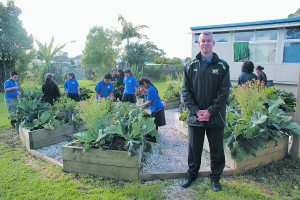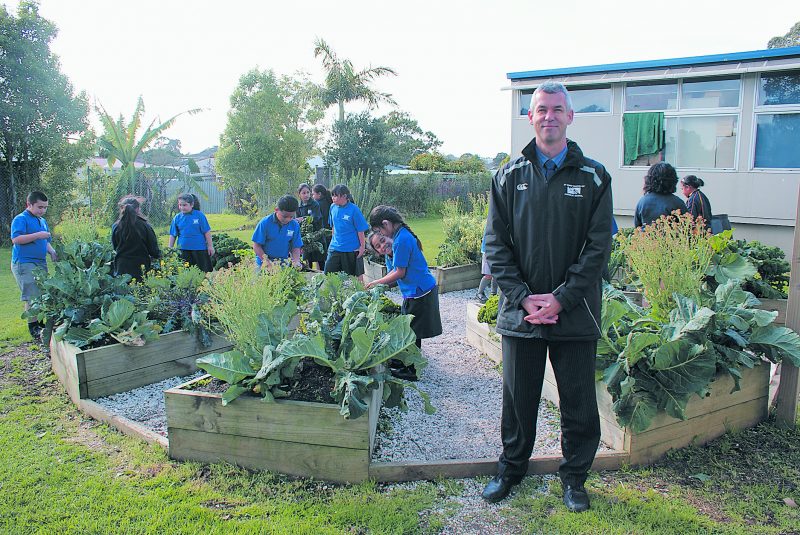by MICHAEL OTTO
AUCKLAND — Children often changing schools is an ongoing issue in south Auckland, but local Catholic schools in the area seem to have more stable enrolments.

St Mary MacKillop Catholic School principal Glen Ryan with students in the school’s garden in Mangere.
As long ago as 1997, the Education Review Office acknowledged that student transience is a barrier to student achievement.
In May, the Child Poverty Action Group (CPAG) produced a report addressing the issue and the
comments from schools showed the depth of the problem.
One principal quoted referred to his school as having “a revolving door”.
“Often these kids come with low self-esteem and little interest in learning,” another school responded.
Another noted an 8-year-old who had been to 12 different schools in the past year, another that “a new enrolment in year 4 has already attended 11 schools”.
Yet another said, “Throughout 2013, we had a family that would move between Auckland and Hastings multiple times, depending on the fruit picking season”.
One principal put it bluntly: “I know from years of experience that transience always
increases when poverty grows more markedly.”
The CPAG’s The revolving door: Student mobility in Auckland schools compared a recent
study into student transience in south and west Auckland schools with a similar south
Auckland survey in 2002.
About 52 mostly low decile primary schools responded to the 2014 survey, which showed
an overall turnover rate of 22 per cent.
This was an improvement on the 29 per cent result from 2002.
Catholic schools
The report also noted that Catholic schools in the sample had lower overall turnover rates than others in similar areas.
One school put this down to the fact that parents didn’t have a choice of other Catholic
schools in the area.
The deputy principal of decile 2 St Anne’s Catholic School in Manurewa, Ann Cottle, agreed with this reasoning.
“If you are going to move from school to school, you are not going to be able to move to
another Catholic school. This makes a big difference,” Mrs Cottle said. “Plus the parents
who come here, they bypass other schools to come to us, so they want to maintain that contact
with our school,” she said.
“They have got that faith issue too, which you don’t have for a state school. There’s nothing
to drive you into a state school, is there, so it is easy just to change.”
Glen Ryan, principal of decile 1 St Mary MacKillop Catholic School in Mangere, was not
surprised at the lower turnover rate for Catholic schools.
“I think our parents value the education and they send their children here for a reason.
They are committed to the school,” Mr Ryan said.
Families send their children from as far away as Manurewa and Hillsborough to attend
the Mangere Catholic school, he said.
“They are really committed to the school and they value what the school offers,” Mr
Ryan said.
“They love the traditions, they love the respect and the culture at the school, they lovethe feeling of being a family, being a part of it,” he added.
Indeed, the CPAG report suggested that “one way to mitigate high rates of transience
among students might be for schools to engage better with families where this is
practicable”.
One state school said that although their transience rates were high, “we have a more
stable roll in our Samoan and Maori bilingual units; our parents and community are more
engaged and committed to attending and remaining in these units”.
Hardship
But both Mr Ryan and Mrs Cottle acknowledge there is hardship in the communities
they draw students from.
Both nominated affordable housing as the number one financial issue for families who
attend their schools.
“This year we have had increasing numbers in our school, but some of the families
have left to go further south to Manurewa [where] the cost of housing is lower,” Mr Ryan said.
Mrs Cottle said affordable housing is a big issue in south Auckland.
“You will have a family that moves into a home and they can’t afford the rent, so they
will shift into someone else’s garage or the house and overcrowd the house, because they
can’t afford their own house,” she said. “Probably our parents who are actually the hardest
off try the hardest to pay everything and keep their kids clothed and fed,” she added.
Parents in need can be helped with compulsory attendance dues for Catholic
schools, she said.
With KidsCan support, St Anne’s can also offer children in need things like shoes and
jackets, as well as a breakfast club, when required.
“We don’t advertise it widely, but we know the children who aren’t eating, so we just take
them quietly and they have breakfast,” Mrs Cottle said.
Mr Ryan is grateful for the Milk in Schools and Fruit in Schools programmes that operate
in his school, with the help of outside sponsorship.
Attachment
CPAG researcher Donna Wynd, who wrote the 2014 report, was wary of identifying a trend between two studies more than a decade apart.
But she understood why Catholic schools in the survey had lower turnover rates.
“If you are going to spend the money and take the trouble to send your kids to a Catholic
school, then you kind of have more of a stake in it, you are more grounded,” she said.
She was prompted to write the report by looking at children who have come and gone in her own neighbourhood, in Otahuhu.
Ms Wynd worries that “we are creating a core of children who are going to grow up with no attachment to anything or anyone”.
“When I was growing up, we knew all the people in the neighbourhood, we had a sense of place, we had a stake in our world. But if you have kids who don’t have that, why do they care?”
Her report notes that it is not just academic results that are affected; it is also
children’s relationships with their peers.
One school noted children who shifted frequently had trouble forming friendships, while a former teacher observed that transient children tended to be attention- seeking and disruptive, or withdrawn.
Factors that appear to impact on whether moving is positive or not include the reasons for shifting and what say children have in the process.
Solutions
But whatever the reason for the transience, often these children are faced with compounding
disadvantage.
Those problems go well beyond the scope of the education sector, the CPAG report noted.
“Government efforts to improve education outcomes by focusing on teacher quality and
test results fail to place children’s education in the context of children’s broader economic
and social needs,” it added.
“A broad-based commitment is needed to ensure families have stable, affordable accommodation,
and that economic growth provides steady, well paid jobs,” it concluded.
But Ms Wynd fears that despite the positive media coverage when her report was released in May, this doesn’t seem to have translated into worthwhile policy initiatives.
As she noted in her study: “Apart from comments hidden in ERO reports and occasional media reports, [transience] is largely unacknowledged and unexplored.”

Reader Interactions